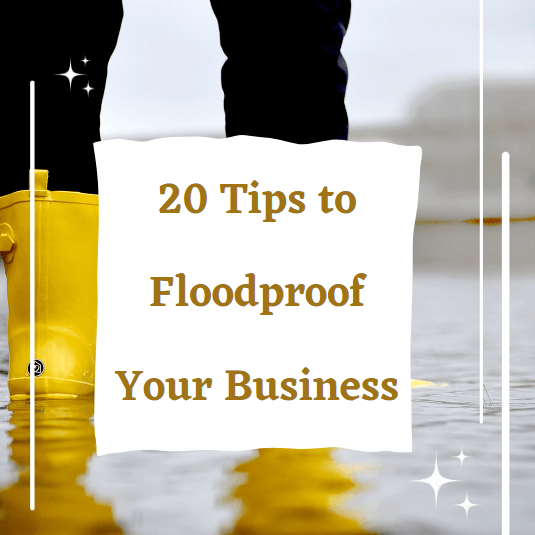Flooding is one of the most serious hazards, causing the most damage to homes and businesses. Commercial buildings, like any other property, are vulnerable to costly weather-related damage, but by being adequately prepared and taking the necessary precautions, you can help flood proof your commercial organization. Are you concerned that a flood would harm or destroy your company's assets? Keep your business safe with these 20 floodproof tips.
1 - Understand your flood zone.
Visit FEMA's Flood Map Service Center or contact your municipal or county government to look up your home on a local flood map. Flooding can occur outside of the flood map's high-risk flood zones. More information is available at floodsmart.gov.
2 - Estimate your BFE.
Determine if the elevation of your building's lowest level is above or below the BFE by learning the base flood elevation (BFE) for your property.
If your structure is below ground, consider raising it to lessen the likelihood of flooding. Buildings should be at least 3 feet above the BFE to accommodate for higher-than-expected flood levels.

3 - Use dry floodproof methods.
If your structure is in or near a flood-prone location, consider using these dry floodproofing measures to make it waterproof and keep floodwaters out.
- Keep a stock of flood-protective materials/products on available to assist redirect water away from the structure, such as water-absorbent barriers or sandbags for relatively shallow flooding, or plastic sheeting/tarps for somewhat deep flooding.
- Install watertight shields over all doors and windows that are at least 3 feet above the BFE or, if known, the 500-year flood level. The sort of barrier utilized will be determined by the size and shape of the entrance.
- Water-filled barriers can be linked and piled to deflect water away from openings in large parts of a structure that may be exposed to deeper flood levels, such as big commercial doors or entranceways.
- install flood gates, permanent swing flood doors, or submarine doors (the latter two offer permanent flood protection for deeper water).
- Permanent flood barriers that encircle the property may be considered for recurring deep and persistent floods.
4 - Get flood insurance.
Purchase flood insurance if you live in or near a high-risk flood zone (Special Flood Hazard Area). The government National Flood Insurance Program (NFIP) provides flood insurance, which can be obtained via private insurance brokers and firms.
5 - Use native plants to floodproof
Plant native plants and vegetation to help minimize soil erosion and allow flood waters to flow more efficiently.
6 - Elevate electrical components
Hiring a certified electrician to raise electrical components (switches, sockets, circuit breakers, and wiring) at least 12 inches above the BFE for your location is a good idea. This will assist to minimize electrical system damage and lessen the risk of fire from short circuits in flooded systems.
7 - Raise or floodproof your HVAC system.
To avoid damage, raise or floodproof heating, ventilation, and cooling (HVAC) equipment. Hire a contractor to relocate it to a higher floor or construct a floodproof wall around the equipment.
8 - Prefer floodproof materials.
When feasible, use flood-resistant materials such as floor coverings, wall coverings, and wall insulation. The majority of flood-resistant materials can endure direct contact with water for at least 72 hours without severe harm.

9 - Add a backup power source.
Backup power might be crucial in lowering recovery time. Plan ahead of time for backup power requirements for critical equipment required to restart operations. Consider power for mechanical equipment such as your air conditioning systems as well, since this may lower humidity and moisture levels, allowing items to dry and inhibiting mold growth. Ascertain that backup power and related equipment are elevated and/or shielded from storm waters.
10 - Know where the disconnect valves and cut-off points (gas, water, and electricity) are.
11 - Repair all cracks.
Seal cracks and utility pipe penetrations using high-quality urethane-based caulk.
12 - Use floodproof coating.
Apply a waterproof coating or membrane to the outside and/or basement walls, paying special attention to areas where leaks have occurred.
13 - Examine the downspouts.
Ensure that downspouts direct water away from the structure to avoid rainfall from gathering along the building's perimeter.
14 - Examine the slope
Make sure the land's slope channels water away from the structure.
15 - Anchor fuel tanks
Anchor gasoline tanks that might otherwise cause damage to your structure or be washed downstream, causing harm to nearby buildings. When they separate, the contents may leak, posing fire, explosion, and pollution threats that can harm health and the environment.
16 - Install a sewer backflow prevention valve.
Install an interior or exterior sewer backflow valve to prevent sewage from sanitary sewer lines from backing up into the building through drain pipes.

17 - Install a sump pump.
Purchase or rent a portable sump pump and link it to a generator or battery backup. Consider adding a sump pump backup, which starts pumping automatically during power outages, when the main pump fails, or when water flow exceeds the main pump's capacity. Test the backup power system on a regular basis and make sure the batteries are always fresh.
18 - Examine wells
Hire a professional well-drilling contractor to check your well and provide recommendations for upgrades to safeguard it from floodwater pollution.
19 - Secure valuables
Keep valuable equipment, records, and inventory out of any crawlspace or basement where flooding is a possibility.
20 - Keep updated.
Make sure to check the market of flood control solutions and see if there are any new products that can floodproof your business better than the ones you have used before.
Contact Dam Easy for the latest information about modern flood control solutions and the most efficient flood gates and other means of floodproofing for residential and commercial estate.
Flood Barrier Door Dam - Ultimate Flood Gate

€779,00
DAM EASY® FLOOD GATE - DOOR DAM Floods are becoming more common around the world. What was once a 100-year phenomenon is now a seasonal trend that homeowners must deal with. That’s EXACTLY why you need this Dam Easy Flood… Read More



